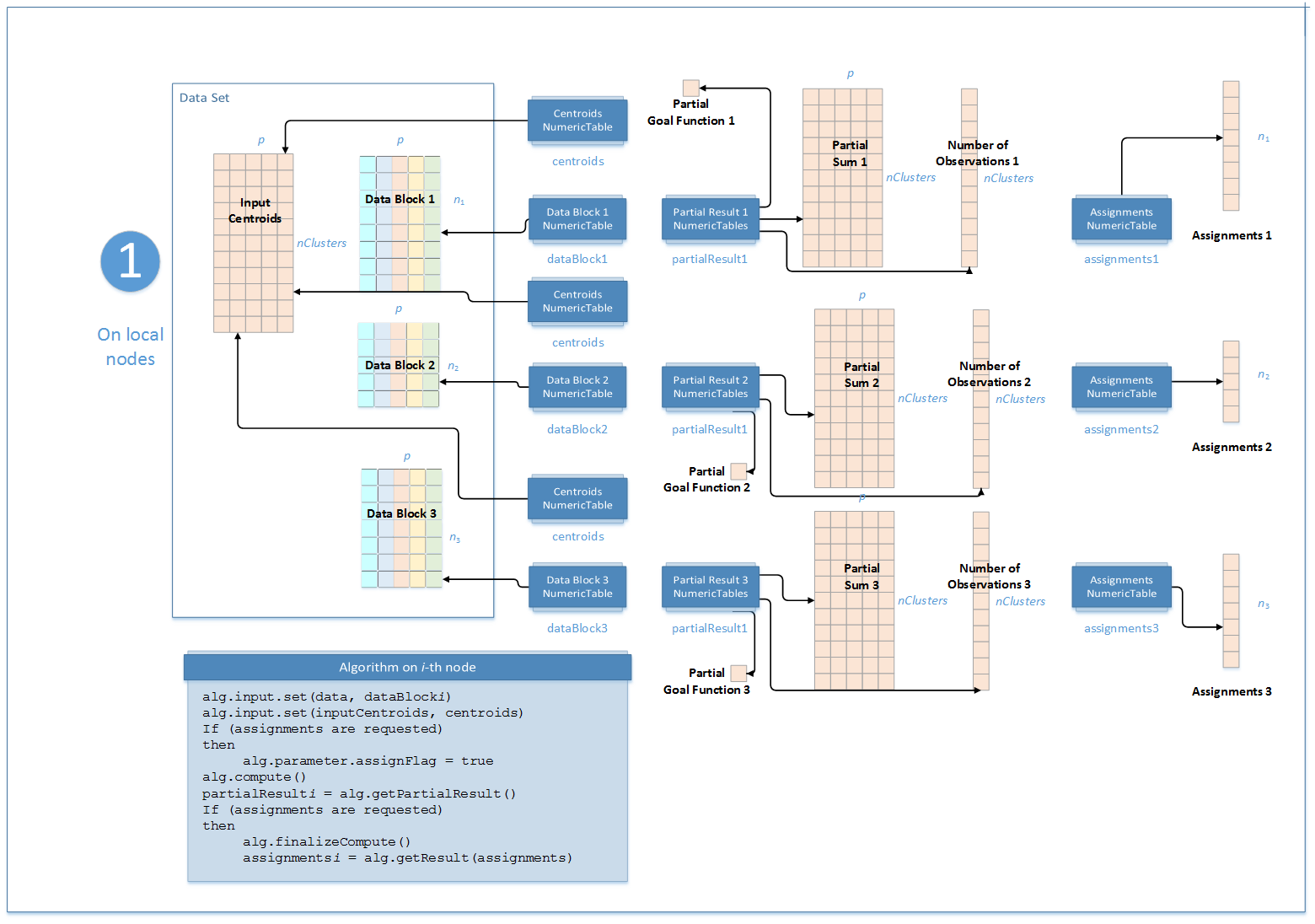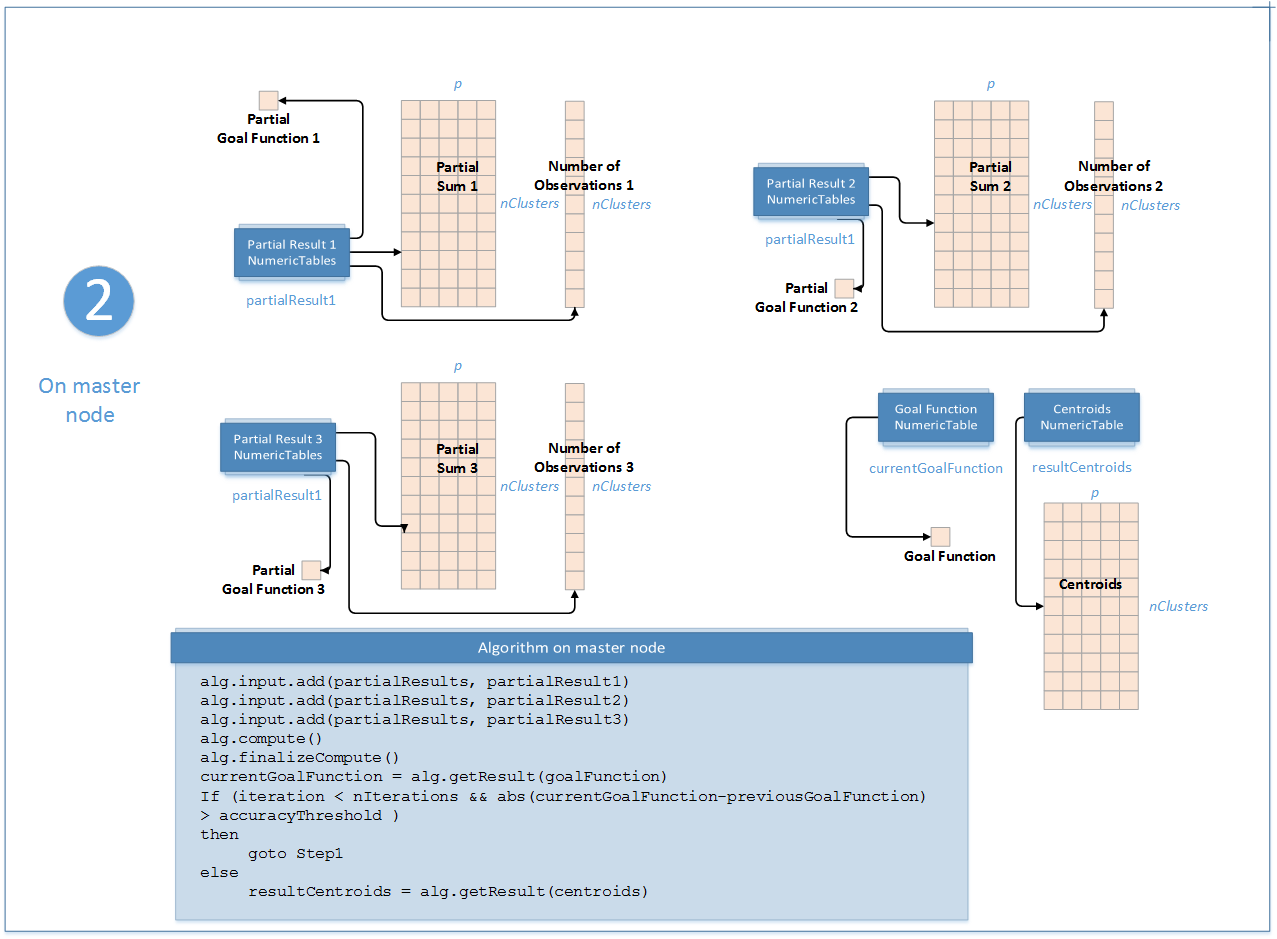This mode assumes that the data set is split into nblocks blocks across computation nodes.
Algorithm Parameters
The K-Means clustering algorithm in the distributed processing mode has the following parameters:
|
Parameter |
Default Value |
Description |
|
|---|---|---|---|
|
computeStep |
Not applicable |
The parameter required to initialize the algorithm. Can be:
|
|
|
algorithmFPType |
double |
The floating-point type that the algorithm uses for intermediate computations. Can be float or double. |
|
|
method |
defaultDense |
Available computation methods for K-Means clustering:
|
|
|
nClusters |
Not applicable |
The number of clusters. Required to initialize the algorithm. |
|
|
gamma |
1.0 |
The weight to be used in distance calculation for binary categorical features. |
|
|
distanceType |
euclidean |
The measure of closeness between points (observations) being clustered. The only distance type supported so far is the Euclidian distance. |
|
|
assignFlag |
false |
A flag that enables computation of assignments, that is, assigning cluster indices to respective observations. |
|
To compute K-Means clustering in the distributed processing mode, use the general schema described in Algorithms as follows:
Step 1 - on Local Nodes

In
this step, the K-Means clustering algorithm accepts the input described below.
Pass the Input ID as a parameter to the methods that provide input for your
algorithm. For more details, see
Algorithms.
|
Input ID |
Input |
|
|---|---|---|
|
data |
Pointer to the ni x p numeric table that represents the i-th data block on the local node. The input can be an object of any class derived from NumericTable. |
|
|
inputCentroids |
Pointer to the nClusters x p numeric table with the initial cluster centroids. This input can be an object of any class derived from NumericTable. |
|
In this step, the K-Means clustering algorithm calculates the partial results and results described below. Pass the Partial Result ID or Result ID as a parameter to the methods that access the results of your algorithm. For more details, see Algorithms.
|
Partial Result ID |
Result |
|
|---|---|---|
|
nObservations |
Pointer to the nClusters x 1 numeric table that contains the number of observations assigned to the clusters on local node. By default, this result if an object of the HomogenNumericTable class, but you can define this result as an object of any class derived from NumericTable except CSRNumericTable. |
|
|
partialSums |
Pointer to the nClusters x p numeric table with partial sums of observations assigned to the clusters on the local node. By default, this result is an object of the HomogenNumericTable class, but you can define the result as an object of any class derived from NumericTable except PackedTriangularMatrix, PackedSymmetricMatrix, and CSRNumericTable. |
|
|
partialGoalFunction |
Pointer to the 1 x 1 numeric table that contains the value of the partial goal function for observations processed on the local node. By default, this result is an object of the HomogenNumericTable class, but you can define this result as an object of any class derived from NumericTable except CSRNumericTable. |
|
|
Result ID |
Result |
|
|
assignments |
Use when assignFlag = true. Pointer to the ni x 1 numeric table with 32-bit integer assignments of cluster indices to feature vectors in the input data on the local node. By default, this result is an object of the HomogenNumericTable class, but you can define this result as an object of any class derived from NumericTable except PackedTriangularMatrix, PackedSymmetricMatrix, and CSRNumericTable. |
|
Step 2 - on Master Node

In
this step, the K-Means clustering algorithm accepts the input from each local
node described below. Pass the Input ID as a parameter to the methods that
provide input for your algorithm. For more details, see
Algorithms.
|
Input ID |
Input |
|
|---|---|---|
|
partialResuts |
A collection that contains results computed in Step 1 on local nodes. |
|
In this step, the K-Means clustering algorithm calculates the results described below. Pass the Result ID as a parameter to the methods that access the results of your algorithm. For more details, see Algorithms.
|
Result ID |
Result |
|
|---|---|---|
|
centroids |
Pointer to the nClusters x p numeric table with the cluster centroids. By default, this result is an object of the HomogenNumericTable class, but you can define the result as an object of any class derived from NumericTable except PackedTriangularMatrix, PackedSymmetricMatrix, and CSRNumericTable. |
|
|
goalFunction |
Pointer to the 1 x 1 numeric table that contains the value of the goal function. By default, this result is an object of the HomogenNumericTable class, but you can define this result as an object of any class derived from NumericTable except CSRNumericTable. |
|
Important
The algorithm computes assignments using input centroids. Therefore, to compute assignments using final computed centroids, after the last call to Step2 compute() method on the master node, on each local node set assignFlag to true and do one additional call to Step1 compute() and finalizeCompute() methods. Always set assignFlag to true and call finalizeCompute() to obtain assignments in each step.
Note
To compute assignments using original inputCentroids on the given node, you can use K-Means clustering algorithm in the batch processing mode with the subset of the data available on this node. See Batch Processing for more details.